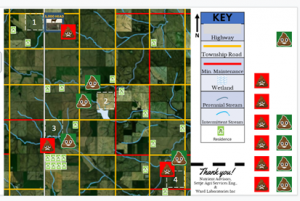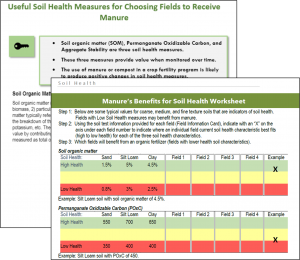coming soon
Implications of Managing Manure on a Nitrogen Basis
Meeting crop nitrogen needs with manure while overapplying other nutrients can save the crop farmer the cost of additional fertilizer, but every decision on a farm has consequences. This webinar discusses using whole farm and field-based nitrogen (N) and phosphorus (P) balances to identify opportunities for improvements in nutrient use and monitor the impact of management changes over time, the time necessary to reduce the soil phosphorus levels, and the issues with zinc accumulation in soils. This presentation was originally broadcast on March 15, 2024. Continue reading “Implications of Managing Manure on a Nitrogen Basis”
Upcoming Models and Tools to Improve Manure Management
Responsible manure management uses multiple data types from a wide range of sources. This webinar highlights three new tools that aim to ease this burden while supporting effective decision-making. ManureDB aggregates U.S. manure analysis data and provides user-specified reports of manure characteristics. ManureTech synthesizes the environmental, economic and operational facets of manure treatment technologies. Manure Management Planner is a trusted tool but has also undergone recent updates for site-specific setback distances. Participants will be able to see these tools in action, and where further developments are headed. This presentation was originally broadcast on February 16, 2024. Continue reading “Upcoming Models and Tools to Improve Manure Management”
Animal Feeding Operations Air Emission Estimation Methods
To be sustainable, producers need to conserve energy while still maintaining or improving their facilities and the lives of the animals they house. This presentation was originally broadcast on January 19, 2024. Continue reading “Animal Feeding Operations Air Emission Estimation Methods”
Minimizing Risk on Livestock & Poultry Operations
In the Livestock and Poultry Environmental Learning Community, we are well aware that @#$% happens. In this webinar, presenters share insurance considerations and ways to minimize risk on livestock and poultry operations. This presentation was originally broadcast on November 17, 2023. Continue reading “Minimizing Risk on Livestock & Poultry Operations”
Interactive Nutrient Management Decision-Making Exercise Curricula

An educational curricula was pilot tested in 2020 by Extension professionals in Nebraska and Minnesota. It utilizes a table-top sized map game board, six pre-planned scenarios, and interactive planning by small groups to select preferred manure application sites. The original curricula addresses:
-
- How far will I need to travel to manage manure nitrogen? Phosphorus?
- Which fields benefit the most agronomically from manure?
- How far can I afford to travel?
- Which fields benefit most from manure’s soil health benefits?
- What water quality risks are connected with individual fields?
- How can I use a weather forecast to minimize neighbor’s odor risks?
These activities often lead to lots of peer-to-peer teaching. For example, we have witnessed discussions about minimizing compaction and planning to minimize impacts on community infrastructure and neighbors. As participants work through these discussions, they add visual reminders (i.e. happy and sad face emojis) to the map to weigh the benefits and concerns connected to individual fields.
Over the course of the last several years, the curricula has been expanded. There are now additional activities on the following topics:
-
- Crediting nitrogen from all sources to choose a nitrogen rate
- Determining value of commercial fertilizer nutrients
- Determining manure availability
- Observing setbacks and stockpiling manure
- Reading soil and manure samples
Resources are Available for Adapting to Your State
The curricula includes:

-
- a 25-square mile map,
- scenarios set up for seven alternative animal feeding operations (you pick one for your group),
- Seven alternative fields for land application with record and information cards (soil tests, soil health tests, nutrient removal rates, water quality risk indicators),
- worksheets for each of the activities, and
- a facilitator guide to help set up the scenario.
You may download electronic copies of all resources, adapt to your state, and begin sharing a highly interactive and peer-to-peer educational experience.
Downloadable Resources
Thank you for your interest in the curricula. Please fill out the following form to access the files:
Contacts
Models & Tools to Improve Manure Management: Part II
This webinar features the Oregon NMPT, an internet-based record keeping and planning tool, and the Ruminant Farm Systems (RuFaS) project, which aims to build an integrated, whole-farm model that simulates milk, meat, and crop production, and critical metrics of sustainability from ruminant farms. This presentation was originally broadcast on October 20, 2023. Continue reading “Models & Tools to Improve Manure Management: Part II”
Implications of Manure Additives: Both Purposeful and Accidental
This webinar discusses purposeful additives like nitrification inhibitors and biochar as well as accidental additives like copper sulfate from disinfecting foot baths and how these things can and should impact our decisions when applying manure. This presentation was originally broadcast on September 22, 2023. Continue reading “Implications of Manure Additives: Both Purposeful and Accidental”
Vector Control on Livestock Operations
This webinar will focus on the importance of controlling these pests and the safety of the livestock, the caretakers, and non-target animals and insects around the farm when doing so. This presentation was originally broadcast on June 16, 2023. Continue reading “Vector Control on Livestock Operations”
Models & Tools to Improve Manure Management
This webinar highlights one tool that provides resources to support livestock production and expansion, as well as two others that focus on manure application planning and making the best use of manure available. This presentation was originally broadcast on May 19, 2023. Continue reading “Models & Tools to Improve Manure Management”

